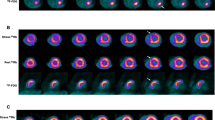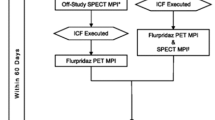Abstract
Background
The diagnosis of coronary artery disease (CAD) in women continues to be a challenge. f-18 deoxyglucose (FDG) positron emission tomography (PET) has been used for detection of myocardial ischemia at rest. Little has been reported about FDG stress imaging. The aim of this pilot study was to assess stress FDG PET imaging for defining CAD in a group of women referred for chest pain.
Methods
Stress FDG imaging was performed in 19 women (mean age 59±10 years). All had abnormal stress testing before entering the study. FDG and 2-methoxy-2-methylpropyl isonitrile were injected at peak stress (treadmill n=8, dipyridam ole n=11) followed by PET and single photon emission computed tomography image acquisitions. Myocardial ischemia was defined by regions that demonstrated both a defect on perfusion imaging and increased FDG uptake relative to uptake in normal perfusion zones. Defect/normal zone FDG ratios were also determined. Coronary angiography was performed on all patients.
Results
Average, or mean, body mass index was high at 29.2±5kg/m2. Nine of 19 patients had significant CAD. Eight of 9 with CAD had FDG-defined ischemia. Nine of the 10 without CAD had negative FDG images (sensitivity 89%., specificity 90%). The average defect/normal zone FDG ratio was greater in patients with CAD than in those without (2.4±1.9 vs 0.9±0.4, P<.05).
Conclusions
Regional FDG uptake in areas of perfusion defects with stress increased in this group with CAD. These pilot data suggest that stress FDG PET may be diagnostically helpful in obese female patients. This novel approach may complement current methods of CAD detection in women and warrants further study.
Similar content being viewed by others
References
Barolsky SM, Gilbert CA, Faruqui A, Nutter DO, Schlant RC. Differences in electrocardiogram response to exercise of women and men: a non bay sian factor. Circulation 1979;60:1021–7.
Hung J, Chaitman BR, Lam J, Lesperance J, Dupras G, Fines P, et al. Noninvastive diagnostic test choices for the evaluation of coronary artery disease in women: a multivariate comparison of cardiac flouroscopy, exercise electrocardiography and exercise thallium myocardial perfusion scintigraphy. J Am Coll Cardiol 1984;4:8–16.
Schlant RC, Gotlieb CF, Leonard JL: Clinical competence in exercise testing: ACP/ACC/AHA task force statement. J Am Coll Cardiol 1990;16:1061–5.
Hachamovitch R, Berman DS, Kiat H, Merz CNB, Cohen I, Cabico JA, et al. Effective risk stratification using exercise myocardial perfusion SPECT in women: gender-related differences in prognostic nuclear testing. J Am Coll Cardiol 1996;28:34–44.
Iskandrian AS, Heo J, Kong B, Lyons E. Effect of exercise level on the ability of thallium-201 tomographic imaging in detecting coronary artery disease: analysis of 461 patients. J Am Coll Cardiol 1989;14:1477–86.
Chae S, Heo J, Iskandrian AS, Wasserleben V, Cave V. Identification of extensive coronary artery disease in women by single-photon emission computed tomographic (SPECT) thallium imaging. J Am Coll Cardiol 1993;21:1305–11.
Friedman TD, Greene AC, Iskandrian AS, Hakki AH, Kane SA, Segal BL. Exercise thallium-201 myocardial scintigraphy in women: correlation with coronary angiography. Am J Cardiol 1982;49:1632–7.
Taillefer R, DePuey EG, Udelson JE, Beller GA, Latour Y, Reeves F. Comparative diagnostic accuracy of Tl-201 and Tc-99m-sestamibi SPECT imaging (perfusion and ECG-gated SPECT) in detecting coronary artery disease in women. J Am Coll Cardiol 1997;29:69–77.
Kong BA, Shaw L, Miller DD, Chaitman BR. Comparison of accuracy for detecting coronary artery disease and side effect profile of dipyridamole thallium-201 myocardial perfusion imaging in women vs men. Am J Cardiol 1992;70:168–73.
Kiat H, Maddahi J, Roy LT, Van Train K, Friedman J, Resser K, et al. Comparison of technetium 99m methoxy isbutyl isonitrile and thallium 201 for evaluation of coronary artery disease by planar and tomographic methods. Am Heart J 1989;117:1–11.
Shaw LJ, Miller DD, Romeis JC, Kargl D, Younis LT, Chaitman BR. Gender differences in the noninvasive evaluation and management of patients with suspected coronary artery disease. Ann Intern Med 1994;120:559–66.
Patterson RE, Eisner RL, Horowitz SF. Comparison of cost-effectiveness and utility of exercise ECG, single photon emission computed tomography, positron emission tomography, and coronary angiography for diagnosis of coronary artery disease. Circulation 1995;91:54–65.
Tillisch J, Brunken R, Marshall R, Schwaiger M, Mandelkem M, Phelps M, et al. Reversibility of cardiac wall-motion abnormalities predicted by positron tomography. N Engl J Med 1986;314:884–8.
Maddahi J, Schelbert H, Brunken R, DiCarli M. Role of thallium-201 and PET imaging in evaluation of myocardial viability and management of patients with coronary artery disease and left ventricular dysfunction. J Nucl Med 1994;35:707–15.
Morton BC, Gill JB, Roberts RS, Laroque BG, Jozwiak LA, Cairns JA. Does it matter how coronary projections are combined to assess restenosis following PTCA? Int J Card Imaging 1995;11:145–9.
Tillisch J, Brunken R, Marshall R, Schwaiger M, Mandelkern M, Phelps M, et al. Reversibility of cardiac wall-motion abnormalities predicted by positron tomography. N Engl J Med 1986;314:884–8.
Maddahi J, Schelbert H, Brunken R, DiCarli M. Role of thallium-201 and PET imaging in evaluation of myocardial viability and management of patients with coronary artery disease and left ventricular dysfunction. J Nucl Med 1994;35:707–15.
Gallagher BM, Ansari A, Atkins H, Casella V, Christman DR, Fowler JS, et al. Radiopharmaceuticals. 18-F-labeled 2 deoxy-2-fluoro-D-glucose as a radiopharmaceutical for measuring regional my ocardial glucose metabolism in vivo: tissue distribution and imaging studies in animals. J Nucl Med 1977;18:990–6.
Marshall RC, Tillisch JH, Phelps ME, Huang S, Carson R, Henze E, et al. Identification and differentiation of resting myocardial ischaemia and infarction in man with positron computed tomography, 18F-labeled fluorodeoxyglucose and N-13 ammonia. Circulation 1983;67: 766–78.
Beanlands RSB, Hendry PJ, Masters RG, deKemp RA, Woodend K, Ruddy TD. Delay in revascularization is associated with increased mortality in patients with severe LV dysfunction and viable myocardium on FDG PET imaging, Circulation 1998;98:II51–6.
Camici P, Ferrannini E, Opie LH. Myocardial metabolism in ischemic heart disease. Basic principles and application to imaging by positron emission tomography. Prog Cardiovasc Dis 1989;32:217–38.
Camici P, Araujo LI, Spinks T, Lammertsma AA, Kaski JC, Shea MJ, et al. Increased uptake of 18-F-fluorodeoxyglucose in postischemic myocardium of patients with exercised induced angina. Circulation 1986;74:81–8.
Krivokapich J, Barrio JR, Huang S, Schelbert R Dynamic positron tomographic imaging with nitrogen-13 glutamate in patients with coronary artery disease: comparison with nitrogen-13 ammonia and fluorine-18 fluorodeoxyglucose imaging. J Am Coll Cardiol 1990;16:1158–67.
Camici P, Araujo L, Spinks T, Lammertsma AA, Jones T, Maseri A. Myocardial glucose utilization in ischaemic heart disease: preliminary results with F18-fluorodeoxyglucose and positron emission tomography. Eur Heart J 1986;7 (suppl): 19–23.
Marwick T, Nemec JJ, Lafont A, Sacedo EE, MacIntyre W. Prediction by postexercise fluoro-18 deoxyglucose positron emission tomography of improvement in exercise capacity after revascularization. Am J Cardiol 1992;69:854–9.
Gropler RJ, Siegel BA, Lee KJ, Moerlein SM, Perry DJ, Bergmann SR, et al. Nonuniformity in myocardial accumulation of fluorine,-18-fluorodeoxyglucose in normal fasted humans. J Nucl Med 1990;31:1749–56.
Gibbons RJ, Holmes DR, Reeder GS, Bailey KR, Hopfensprirger MR, Gersh BJ. Immediate angioplasty compared with the administration of a thrombolytic agent followed by conservative treatment for myocardial infarction. N Engl J Med 1993;328:685–91.
Sinusas AJ, Bergin JD, Edwards NC, Watson DD, Ruiz M, Makuch RW, Smith WH, et al. Redistribution of 99m Tc-sestamibi and 201 Tl in the presence of a severe coronary artery stenosis. Circulation 1994;89:2332–41.
Sandler MP, Videlefsky S, Belebeke D, Patton JA, Meyerowitz C, Martin WH, et al. Evaluation of myocardial ischemia using a rest metabolism/stress perfusion protocol with fluorine-18 deoxyglucose/technetium-99m MIBI and dual isotope simultaneous-aquisition single-photon emission computed tomography. J Am Coll Cardiol 1995;26:870–8.
Becker LC. Conditions for vasodilator-induced coronary steal in experimental myocardial ischemia. Circulation 1978;57:1103–10.
Beller GA, Holzgrefe HH, Watson DD. Effects of dipyridamole-induced vasodilation on my ocardial uptake and clearance. Circulation 1983;68:1328–38.
Klein HO, Ninio R, Eliyahu S. Effects of the dipyridamole test on left ventricular function in coronary artery disease. Am J Cardiol 1992;69:482–8.
John RM, Taggart PI, Sutton PM, Costa DC, Ell PJ, Swanton H. Vasodilator myocardial perfusion imaging: demonstration of local electrophysiological changes of ischemia. Br Heart J 1992;68:21–30.
Feldman RL, Nichols WW, Pepine CJ, Conti CR. Acute effect of intravenous dipyridamole on regional coronary hemodynamics and metabolism. Circulation 1981;64:333–44.
Bax JJ, Visser FC, Van Lingen A Huitink JM, Van Leeuwen GR, Visser GWM, et al. Feasibility of assessing regional myocardial uptake of F18 deoxyglucose using single photon emission computed tomography. Eur Heart J 1993;14:1675–82.
Delbeke D, Videlesky S, Patton JA, Campbell MG, Martin WH, Ohana I, et al. Rest myocardial perfusion/metabolism imaging using simultaneous dual-isotope acquisition SPECT with technetium-99m-MIBI/Fluorine-18-FDG. J Nucl Med 1995;36:2110–9.
Bax JJ, Cornel JH, Visser FC, Fioretti PM, Van Lingen A, Reijs AEM, et al. Prediction of recovery of myocardial dysfunction after revascularization. Comparison of fluorine-18 Fluorodeoxyglucose/thallium-201 SPECT, thallium-201 stress-reinjection SPECT and dobutamine echocardiography. J Am Coll Cardiol 1996;28:558–64.
Srinivasan G, Kitsiou AN, Bacharach SL, Miller-Davis C, Dilsizian V. [18F] Fluorodeoxyglucose single photon emission computed tomography: can it replace PET and thallium SPECT for the assessment of myocardial viability? Circulation 1998;97:834–50.
Burt RW, Perkins OW, Oppenheim BE, Schauwecker DS, Stein L, Wellmen HN, et al. Direct comparison of fluorine-18-FDG SPECT, fluorine-18-FDG PET and rest thallium-201 SPECT for detection of myocardial viability. J Nucl Med 1995;36:176–9.
Author information
Authors and Affiliations
Corresponding author
Additional information
Beth L. Abramson, MD, was a Research Fellow supported by the Heart and Stroke Foundation of Canada, Ottawa, Canada, during this study and was supervised by R.S.B. Beanlands.
Terrence D. Ruddy, MD, was a Research, Scholar supported by the Heart and Stroke Foundation of Canada, Ottawa, Canada, during this study.
Rob S.B. Beanlands, MD, is a Research Scientist supported by the Medical Research Council of Canada, Ottawa, Canada.
Rights and permissions
About this article
Cite this article
Abramson, B.L., Ruddy, T.D., deKemp, R.A. et al. Stress perfusion/metabolism imaging: A pilot study for a potential new approach to the diagnosis of coronary disease in women. J Nucl Cardiol 7, 205–212 (2000). https://doi.org/10.1016/S1071-3581(00)70008-0
Received:
Accepted:
Issue Date:
DOI: https://doi.org/10.1016/S1071-3581(00)70008-0




